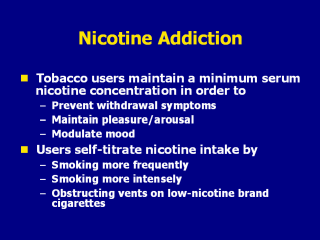 |
As shown in the previous slide, tobacco users
tend to carefully titrate, or regulate, their tobacco intake to maintain a
relatively constant level of nicotine in the body, in order to
-Prevent withdrawal symptoms
-Maintain pleasure/arousal
-Modulate mood (e.g., to handle stress/anxiety)
Although many tobacco users might not think about it consciously, they are
able to alter nicotine delivery in a number of ways, including
-By smoking/dipping more frequently
-By smoking more intensely (e.g., inhaling deeper/longer, smoking cigarette
down to the filter)
-By obstructing the vents (with fingers) on “light” cigarettes, thereby
increasing the amount of nicotine delivered to the lung
Benowitz NL. Nicotine addiction. Prim Care 1999;26:611–631.
Slide is used with permission, Rx for Change: Clinician-Assisted Tobacco
Cessation. Copyright © 1999-2007 The Regents of the University of
California, University of Southern California, and Western University of
Health Sciences. All rights reserved.Go
to Part II of this lecture
 |
Go to Comment Form |
|